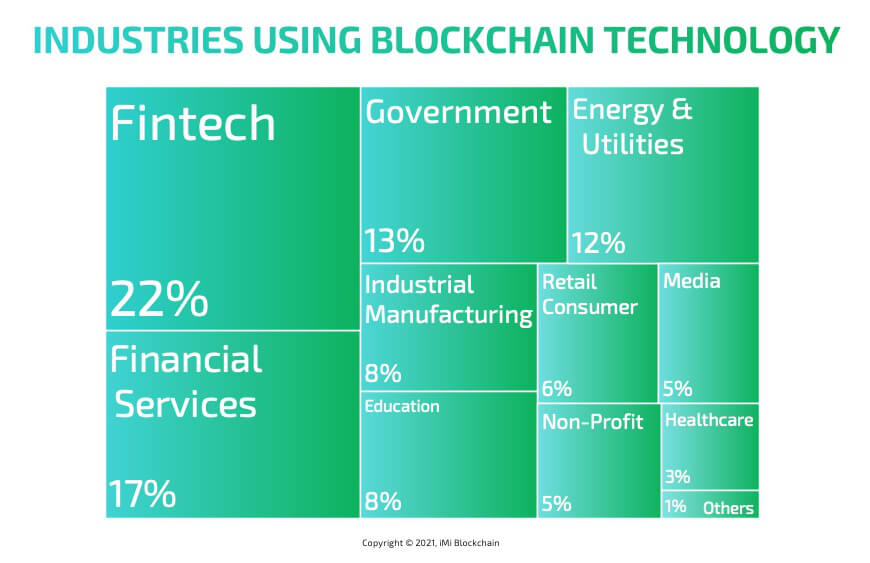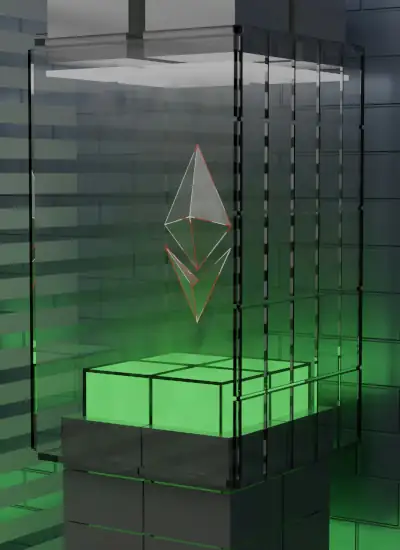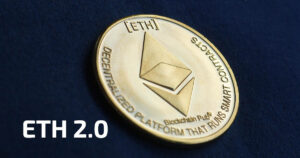
If ever there was a technology for the future, it is blockchain technology. As businesses adjust to the new normal in the post-pandemic period, building system-wide collaboration and optimizing the same is key to ensuring sustained growth for businesses.
Blockchain provides the system to accomplish just that, and how to build your own blockchain should be on your list of priorities. Indeed, across sectors and industries, many are already integrating blockchain into their existing infrastructures. Blockchain technology may very well be the ultimate innovation that resulted from the cryptocurrency boom.
In this article, we’ll take a closer look at blockchain and consider basic reasons why creating a blockchain database might be desirable for your business, what you need to create one, and how to do that from scratch.
Reasons creating a blockchain might be desirable
To have an idea is not enough to become successful. Therefore, before we start, you may consider taking a professional blockchain course at the iMi Academy.
A blockchain is a digital ledger of transactions that is duplicated and distributed within a network of computer systems. It is essentially made up of two separate terms, ‘block’ and ‘chain’. A block is a collection of data, alias data records, and chains stored together in a list. These lists are then interlinked using cryptography, making it the most essential and fundamental requirement for creating a blockchain.
Each block in the chain contains a number of transactions, and every time a new transaction occurs on the blockchain, a record of that transaction is added to every participant’s ledger. Thus, the list continues to grow as more blocks get appended per time forming chains.
Often, the chains are append-only. This means that data can only be added to the system. This is done in a time-ordered and sequential manner. What this means is that data once added is almost impossible to change. This makes the blockchain infrastructure in every practical sense immutable.

Unlock the Code: Master Blockchain Programming!
Dive into the world of decentralized technology with our comprehensive online programming courses. Learn at your own pace and get:
Access – to expert instructors.
Interactive – coding exercises.
Vibrant – community of like-minded learners.
Certified – receive your recognized diploma.
ENROLL TODAY AND TRANSFORM YOUR FUTURE!Industries that are building blockchain applications
The advent of blockchain technology has indeed ushered in whole new possibilities. Many industries are exploring ways to integrate technology as a way to streamline their business processes. A key way many are looking to achieve this is through the creation of a blockchain-based database.

Across sectors and industries, people continue to find use-cases for the technology, and you should too for different reasons. There are many companies that could benefit directly from the creation of a blockchain database. As a standard requirement, businesses that are run both privately or with public access can find a blockchain useful if their product offering requires a high level of integrity. Financial institutions, logistics firms, real estate outfits, and healthcare-based startups amongst others can find the immutability of distributed ledger technology very crucial to their businesses.
There are more ways than one that firms in either one of these sectors can benefit from blockchain technology. Bitcoin and cryptocurrency may very well be the biggest reasons why blockchain got to the limelight but the technology has since moved beyond that.
Here are our top 5 reasons you should consider building a blockchain for your business:
1. Improved security
With data breaches, and cyber fraud taking center stage, we have realized how sensitive and crucial our data is. Blockchain effectively solves this problem. There is no single entry point for hackers because data is not stored centrally.
Again, the system creates unalterable and encrypted records that limit fraud. To do this, the hash of the previous block links to another block, or its parent block, effectively securing the chain from external influence. It also addresses all privacy issues by keeping personal data anonymous and using permissions to prevent unauthorized access.
Of course, this does not mean blockchain networks are 100% secure. Hackers and fraudsters can target blockchain systems in different ways including phishing, routing, Sybil, and 51% attacks (private networks are not affected by the 51% attack). However, compared to other databases, blockchain is definitely more secure.
2. Greater transparency
People often ask, “How can blockchain be private yet transparent?” Well, it truly is even though at first look, it sounds like an oxymoron. The question then is how does this technology balance two seemingly opposite concepts and still manage to create an open and transparent system?
Every blockchain user has a unique address with no personal identifiers. This ensures that the Identify is kept private. Yet, these public addresses are completely open to anyone on the network. This means that anyone with even a remote interest can view the holdings and transactions. That keeps the system transparent.
Again, blockchain’s distributed ledger system allows the same data to be recorded concurrently in multiple locations. All authorized participants on the network can then see the same information at the same time, ensuring total transparency. Additionally, recorded transactions are time- and date-stamped, and unalterable. This means permissioned members can view the entire history of a transaction and easily notice any compromise.
3. Instant traceability
This is particularly useful for those in the supply-chain line. Blockchain makes it easy and fast to pinpoint potential sources of data corruption and helps to efficiently prevent, contain or rectify outbreaks.
Blockchain databases leave a long trail of documents that show the journey of every asset on its journey. Following this trail will help identify any areas of compromise which can then be fixed quickly.
For industries where consumers are bothered about environmental or human rights issues, fake products, and fraud, this helps provide checks and balances. Particularly, this function has found use in the logistics and supply chain industry.
4. Process efficiency and speed
Paper trails are known to be time-consuming, prone to human error, require physical space to store, and often require third-party involvement. By streamlining and automating these processes with blockchain, transactions can be completed faster and more efficiently. Since record-keeping is performed using a single digital ledger that is shared among participants, you don’t have to reconcile multiple ledgers and you end up with less clutter.
When everyone has access to the same information, it becomes easier to trust each other without the need for numerous intermediaries. Thus, clearing and settlement can occur much quicker. The use of a blockchain database eliminates the need for physical documents and information is stored in several locations at the same time. Again, all parties get detailed records of transactions as they happen. Taken together, the transactional process is made faster and more efficient.
5. Automation
Blockchain technology even allows for automated verification by the network of machines itself. It permits machines to exchange value and introduce the element of discretion in the hands of Machines. The efficiency and speed of transactions can be improved further with smart contracts. Essentially, a smart contract is a self-executing contract with preset terms and conditions. Once the pre-specified conditions are met, the transaction or process is automatically triggered. This reduces the need for another delay with verifications.
You should consider how to make your own blockchain if you are desirous of any of these benefits. Additionally, it will make your business more competitive. Already, precedence for its use has been set across industries and sectors including the automotive industry, banking, and financial services, government, healthcare, insurance, media and entertainment, retail industry, etc. You’ll certainly find a model to adopt if you’re contemplating how to create a blockchain database in your industry.

Unlock Your Business Potential with Certified Blockchain Consulting!
Dive into the future of technology with our team of certified blockchain experts. Simply pick the service you need:
Personalized Advice – tailored to your business needs.
Comprehensive Training – for you and your team.
Development Services – innovative solutions from the whitepaper to the finished blockchain.
Programming – with capabilities and tools to succeed.
TALK TO THE EXPERTS TODAYWhat do I need to create a blockchain?
What do you need to create a blockchain? Certainly not much. Generally speaking, creating your own blockchain begins with
- Identifying the need
- Having a clear use case
- Knowledge of processes, tools, platforms, programming languages, etc.
- Enough budget, especially for marketing your dApp
And is summed up in the simple blockchain implementation. But of course, there’s a gap between identifying the need and designing a structure for implementation; a gap that can only be filled by technical expertise. However, the technical knowledge required can be easily grasped by watching online tutorials while the skill can also be learned easily with practice. Invariably, it means if you have an interest in it, and find a use for it, then you have all you need to create your blockchain.
It is important to note that blockchain protocols adopt different levels of decentralization. The level of adoption is dependent on the maturity of the blockchain solution, the reliability of its incentive models (as proven over time) and consensus mechanisms, and the ability of the blockchain developer (or team) to find the right balance required.
Here’s how to build your own blockchain from scratch
The blockchain development process is not quite as complicated as people often think. But first of all, you should ask yourself a few questions to find out if you really need a blockchain database. If you and your business can say “YES” to all points mentioned in the following graphic, then it may be a great innovation to use blockchain technology:

You can use our blockchain decision tree within your decision process. Now you know why and when to build a blockchain application.
Not only will you be able to create or design it. Next, you can learn how to build your own blockchain in twelve simple steps:
1. Build a winning team
Building your blockchain is one thing. But think ahead! To become successful, you need a team of professionals. You need lawyers, advisors, analysts, marketers, sales and PR professionals, next to top-notch programmers and developers.
2. Create a strategy, vision, and mission
Before you even start coding or testing, you should have a clear strategy, a vision, and a mission. Don’t waste time! A strategic approach is crucial for success.
3. Write a business plan and a project plan
Every successful blockchain project starts with a business plan. Make a proper market analysis, get to know your competitors and potential clients, ensure you have the right organization and know-how, and most importantly, make sure your financial plan is according to your project projections.
4. Identify a Use Case
It is essential that as a business, you first decide if a blockchain solution is what you need. If your business needs any of the following, then you can build a blockchain solution as needed;
- Multiple participants that need to have access to the data
- Need for common and secure database
- Need for transparency
5. Choose the most suitable consensus mechanism for your business
The original blockchain, which powers the bitcoin crypto-currency, used proof of work as a consensus mechanism. But today multiple distributed ledger systems offer a host of consensus mechanisms such as Proof of stake, Byzantine fault-tolerant, Deposit based consensus, Federated Byzantine Agreement, Proof of Elapsed Time, Derived PBFT, Redundant Byzantine Fault Tolerance, Simplified Byzantine Fault Tolerance, Federated consensus, Round-Robin and Delegated Proof of Stake.
Depending upon your use case, you need to choose the consensus mechanism that makes the most sense. For example, for cryptocurrencies and blockchain, POW and PoS are among the most used.
6. Decide on a platform
Several platforms on which to launch your blockchain database already exist. What’s more? They can be accessed for free because they are open source. You can find them on platforms such as GitHub where blockchain developers post their source code. Once you’ve chosen a consensus mechanism, you can then go ahead to decide on a suitable blockchain platform.
Perhaps one other consideration in choosing a blockchain platform can be whether or not it comes with an API. Some come with pre-configured APIs while others don’t. In any case, you’ll need APIs for generating key pairs and addresses, auditing-related functions, data authentication, storage and retrieval, smart-asset lifecycle management –issuance, payment, exchange, escrow and retirement, and smart contracts. The API will come into play once the plan for the blockchain class is complete.
Some of the most popular platforms are Chain Core, Corda, Credits, Domus Tower Blockchain, Ethereum, HydraChain, Hyperledger Fabric, Multichain, Openchain, Stellar, etc
7. Design the Nodes
When setting up the nodes for your blockchain network, you have to ask and answer a few questions. Do you want it to be permissioned or permissionless? Do you want it to be private, public, or hybrid? Do you want it to run on the cloud, on-premise, or both? Your answers to this will determine the design of your node. In addition, you must also decide on the baseline operating system and the preferred hardware configuration (processors, memory, and disk size).
8. Plan the blockchain configuration
Several elements need careful planning and execution when it comes to the blockchain configuration Elements such as permissions, asset issuance, asset re-issuance, atomic exchanges, key management, multi signatures, parameters, native assets, address formats, key formats, and block signatures must all be factored in when designing the blockchain configuration.
9. Design the Admin and User Interface
The backend thus completed, you will need to decide on programming languages, external databases, and servers to use. Programming language can be any of HTML5, CSS, PHP, C#, Java, Javascript, Python, Ruby, Golang, Solidity, Angular JS Nodejs). MySQL and MongoDB are common external databases to choose from too. Servers include Web servers, FTP servers, and mail servers.
10. Incorporate Future Tech
Though a technology from 2008, acceptance of blockchain is only just gaining momentum. It would be good forward-thinking to incorporate one or some of the many new technological advancements into the creation of your blockchain platform. By incorporating techs like artificial Intelligence, data analytics, the Internet of Things, and Machine Learning, for example, you can significantly improve your blockchain solution.
11. Launch your blockchain application
The rolling out and launch of your blockchain application is the event of your lifetime. Celebrate it accordingly but make sure that important guests are invited and also take part. Therefore, a launch needs to be planned properly.
12. Promote your project
Just imagine, you have the most innovative idea but no one knows about it. Promoting your project is the most important after the launch. Make the world aware of your project. This needs marketing, public relations, and therefore, this should be by far the biggest item within your whole budget. Be aware that a global ICO can cost you easily 1 to 1.5 million USD just because of the marketing cost.
Key takeaways on how to make a blockchain application
Blockchain technology is still a nascent technology but it is one that has all the prospects of something that is here to stay. If its benefits appeal to your business, then now is the time to create a blockchain system of your own.
If you need a hand to design your blockchain architecture, or if you need an independent advisor, a team of blockchain professionals, or simply a sparring partner, then consider talking to iMi Blockchain, the Swiss experts in distributed ledger technology. You can book a free initial consultation at any time.
Learn Blockchain!
Book a Blockchain Training
Watch Blockchain Webinars
Take Blockchain Online Courses
Learn Cryptocurrency Trading
Become a Professional
Free Blockchain
News!
Get Blockchain news once a month.
On top, you’ll get our free blockchain beginners course right away to learn how this technology will change our lives.
FAQs on how to make your own blockchain
What does a blockchain look like?
A blockchain is a “cryptographically secured chain of blocks.” Essentially, this is an interconnected chain of blocks with each containing a hash pointer to the previous block(with the exception of the genesis block), a timestamp, and a transaction record. Each new block is added like a stack on the last block.
There are four different types of blockchain; public, private, consortium, and sidechains. Public blockchain networks usually random people to join while maintaining a cloak of anonymity. A public blockchain uses internet-connected computers to validate transactions and achieve consensus. Private blockchain networks use identity to confirm membership and access privileges. Thus only known individuals and organizations can join the network.
The blockchain database once created can be stored using JSON. JSON is a common format that can be read and written easily using Php as a programming language. You can also include an Init method in the chaincode. The init method will serve the initialization function in the chaincode. Usually, this function is never executed. Rather, it will be called in order so as to initialize the chaincode whenever it is started or upgraded.
What is a node in blockchain?
A node is a computer on the blockchain network. It supports the network by validating and relaying transactions. Nodes are core infrastructure in a blockchain network without which the system cannot be implemented or operated. The availability of these nodes is what makes the system distributed and trustworthy. Without nodes, Blockchain is just a database secured with a cryptographic hash.
It is important to note that not every user on the blockchain network is a node. Again, not every node on the network has the same functionality. The specific role of the node is determined by the network. For example, the Hyperledger Fabric blockchain network requires multiple nodes to provide a modular architecture. This includes nodes Membership service providers, users, endorsers, anchors, etc.
What is proof of work in blockchain?
Proof of work (PoW) is a decentralized consensus mechanism that uses huge amounts of energy while solving arbitrary mathematical puzzles. The nonce is the number that blockchain miners solve to receive cryptocurrency. It is an abbreviation for “number only used once,” which is a number added to an encrypted block in a blockchain that, when rehashed, meets the difficulty level restrictions.
POW requires a participating node to prove that the work done and submitted by another user qualifies them to add new transactions to the blockchain. It is the consensus algorithm that secures cryptocurrency networks like bitcoin, litecoin, and Ethereum holders. It was the first consensus mechanism but many others have since been introduced because of its huge energy expenditure, and slow transaction speed.
A common proof of work mining algorithm is the SHA256 hashing algorithm. It generates a unique fixed-sized 256 bit hash. This makes it ideal for checking data integrity. Beyond blockchain, it has further applications e.g. digital signatures, password validation, challenge hash authentication, and anti-tamper.
Can I create my own cryptocurrency?
Absolutely! You can create your own cryptocurrency by building an entirely new blockchain with a coin, by changing the protocol of an existing one, and by creating a token. There are many online tutorials on how to become a cryptocurrency creator (although you will still need to have basic coding skills and a thorough understanding of the system.
If you choose to create a coin, know that this option isn’t suitable if you are looking for an easy and quick way to create your own cryptocurrency free of charge. The process of creating a coin can take as little as 5 minutes. You can just copy the source code of an existing algorithm and create a new variable. Otherwise, you can change the value of something, and that’s all. You have your blockchain and coin. However, you’ll need some extensive coding skills to be able to understand it or even change at all. Also, there will be a need to maintain, support, and promote the coin to people in line with the logic of any blockchain you launch.
Another way to create your own cryptocurrency is to change an existing protocol. This is done by building a token on top of an existing blockchain using the trust, popularity, and consensus mechanism of the underlying technology. For example, you can build a token on top of a strong blockchain system, like Ethereum. This way, your token runs on the secure network shielding it from cyber-fraud attacks. Token creation is less costly in terms of money and time, as you utilize the existing decentralized architecture and implement consensus mechanisms.
What’s an ICO?
ICO is the short form for an initial coin offering. ICOs have been gaining increasing popularity as a way to enjoy crowdfunding. This it does by allowing the trading and recording of shares, or stock ownership using a trustless, unforgeable, public, and encrypted blockchain.
When a startup in the crypto ecosystem wants to raise money through ICO, it will create a whitepaper. The whitepaper outlines the focus of the project, what the completed project will solve for, the amount of money needed, the amount of the virtual tokens that will be kept by the coin creators, the type of money that will be accepted, and the duration of the ICO campaign.



